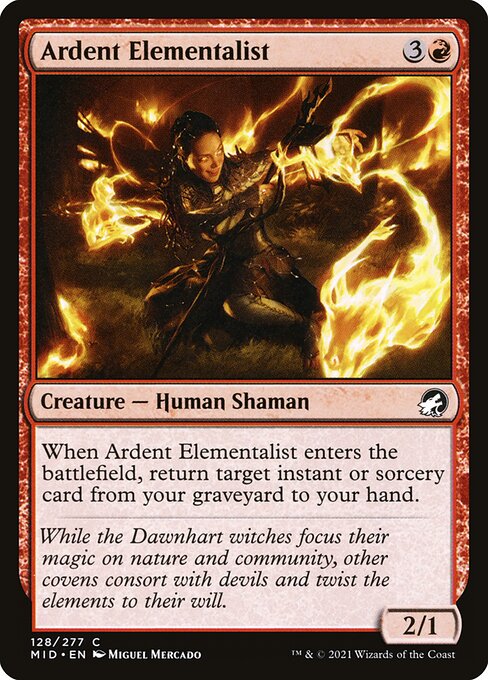
Image courtesy of Scryfall.com
Ardent Elementalist as a Catalyst for Red Archetypes
In the sprawling tapestry of MTG archetypes, red has always thrived on momentum, aggression, and a little chaos. Ardent Elementalist arrives from Innistrad: Midnight Hunt with a straightforward deed and a sly grin: it costs 3R, it’s a 2/1 Human Shaman, and when it enters the battlefield, you get to return target instant or sorcery card from your graveyard to your hand. That one-line ability is a design spark that can ignite entire archetypes around recursive spellplay. It’s not a game-ending bomb, but it’s a reliable engine piece that rewards sequencing, tempo, and a healthy dose of planning. 🧙♂️🔥💎
Card Snapshot
- Name: Ardent Elementalist
- Set: Innistrad: Midnight Hunt (MID)
- Mana Cost: 3R
- Type: Creature — Human Shaman
- Power/Toughness: 2/1
- Rarity: Common
- Text: When this creature enters, return target instant or sorcery card from your graveyard to your hand.
- Color: Red
That ability isn’t just a friendly fetch. It reshapes the late-game decision tree by turning a graveyard into a second hand. In a format that often rewards aggressive starts, having a way to reclaim a key burn spell, a removal spell, or a game-changing instant from the graveyard can swing turns that would otherwise drift toward stalemate. The common rarity keeps this tool accessible, ensuring that even budget brews can experiment with powerful recursions. 🎲
How the ETB Trigger Shapes Archetypes
The Enter-the-Battlefield trigger on Ardent Elementalist creates a dynamic that goes beyond raw card advantage. It nudges players toward archetypes that value "recurring value" over "one-and-done" plays. In a spellslinger framework, you’re stacking cheap, efficient instants and sorceries—cantrips, burn, counterspells, and removal—and you want a reliable way to bring one back for another round. Ardent Elementalist effectively acts as a tempo-conscious engine: you drop it, you reposition your toolkit, and you threaten to replay a key spell that altered the value curve of the previous turn. The result is a red archetype that doesn’t just burn but rebuilds its own resource base on the fly. 🧙♂️⚔️
For players who love graveyard-driven strategies, the card also invites synergy with other effects that interact with the graveyard—think spells with flashback, alternatives like impulse draws, or red staples that fetch back a Lightning Bolt, a Shock, or a removal spell to close out a game. When you pair Ardent Elementalist with such cards, you’re not merely recasting damage or removal—you’re re-teaching your deck how to chain together turns of pressure. The emotional rhythm is satisfying: a hard cast spell, and then a second bite at the apple thanks to the Elementalist’s ETB trigger. It’s red magic with white-knuckle timing. 🧡🔥
Format-agnostic Engagement
Ardent Elementalist proves its versatility across formats. In Commander, red decks are often built around aggressive curves and spell density, and this little 2/1 becomes a constant source of recurring value for cheap, pivotal spells. In Modern and Pioneer, it slots into archetypes that want to maintain near-term pressure while preserving options for the long game—especially in metagames where grindy card advantage is king. Historic players enjoy the same flexibility, with the added spice of a wide card pool that can abuse the graveyard in creative ways. The flavor text reminds us of the set’s gothic tension—Dawnhart covens versus a world full of devils and twisted elements—an evocative backdrop for a card that thrives on choosing the right spell at the right moment. 🧙♂️🎨
Flavor text: “While the Dawnhart witches focus their magic on nature and community, other covens consort with devils and twist the elements to their will.”
Deck-building Suggestions
- Favor a graveyard-friendly spellslinger suite: cheap cantrips, impulsive removal, and direct-damage instants that you’re happy to recast.
- Include cards with flashback or Escape to maximize the value of retrieved spells and keep pressure up even after blockers hit the battlefield.
- Balance tempo and inevitability: don’t tilt too far toward pure burn—make sure there are threats that demand answers while you refill your hand with Ardent Elementalist’s trigger.
- Be mindful of graveyard hate in your playgroup; design your deck to weather disruption by including fetchable or alternative recursions so you don’t lose the engine entirely.
The card’s red identity—speed, risk, and reward—shines brightest when you lean into those archetypes. Its presence in Innistrad: Midnight Hunt also nods to the era’s themes: covens, reanimation vibes, and a relentless push toward improvisation. The art by Miguel Mercado captures a spark of elemental fury, a reminder that even in a world of gothic horror, a single spark can redraw a turn and redraw a fate. 🎨
Collector Value, Design, and Culture
As a common in a popular expansion, Ardent Elementalist doesn’t break the bank—but it does break the sameness of traditional red spells by adding a recurrent engine. Foil versions exist and sparkle in Commander or playgroups that value shine as a signal of a well-loved deck. The set’s position—Innistrad: Midnight Hunt—bridges classic gothic vibes with modern gameplay design, making this card a welcome pick for players who enjoy thematic cohesion alongside mechanical value. For collectors, the card’s accessibility makes it a reasonable entry point into graveyard-centric red builds while keeping room for spicy upgrades. 🔥💎
For fans who want to celebrate the broader MTG multiverse while leveling up their desk battle stations, there’s a tasteful crossover moment: a practical product to accompany your nights of online or in-person games. If you’re curating your workspace for long nights of drafting and deckbuilding, consider a quality surface that can stand up to the tempo of your table and your own spark of inspiration. 🧙♂️🎲